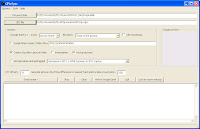The best thing about being jealous is getting even. Last week Gordon and Charlie took a ride to the top of
Flat Top Mesa and I was jealous. [For a free Google Earth file of this route see:
Extra 4 -Flat Top/Toquop]
This week, with nothing else to do, Gordon took me on the trail. We trailer'd up to the Flat Top Mesa trailhead by the water tank and took off over the berm.

Part of the intrigue is that from the city or freeway there doesn't look like there's any way in (you know where) that anything can "git up there." But, as it turned out, there is an unexpected trail to the top which doesn't even require pitons or carabiners.
Near the top there is a gate which must be opened, then
voila you're there. There's few vistas any better, of the Mesquite-Bunkerville valley and Virgin River, thanks to Harold E Wittwer. He, along with his dad and other "old timers," cut and widened the road for the use of pasturing cattle, and are now keeping it open for recreational use.
There is a post with a container of handouts at the top containing the whole story. Its worth the time to visit the several places he mentions. We then went across the mesa to the other side, through the gate and down into
Toquop Wash.
It's a nice ride, as washes go, to the North through multi-colored cliffs, dunes and sage brush. The goal was the powerline and from the ground IT'S REALLY BIG.

There is also the
natural gas pipeline right-of-way under the lines with signs prohibiting riding it due to the desert turtles. But while you're sitting there squinting at the sign to read the small print, the power lines are buzzing above your head - pacemakers beware.
Feet beyond the powerlines there is a crossroad which begins the loop we took. To the left you must rapidly go down into a deep wash directly in the path of the pipes, and you wonder where in (you know where) did they go? They must have "taken a substantial dive" under the same canyon and back up the other side.

From then on to the mountains in the distance, it is like a "Cactophile's" dream. Nearly every cactus and yucca we've seen in this whole area is congregated here - and doing extremely well. The only two missing are the "pencil Cholla" and "Mojave Yucca."
There were the largest examples we've seen of the three
Prickly Pears:
normal,
Beaver Tail and
Mojave (grizzly bear). There were
Silver,
Gold, and
Buckhorn Cholla's along with a clear example of the hybrid as yet unidentified.
Huge
barrels dotted the landscape and nearly filled one whole mountainside. And even many examples of the "
cluster barrel" (cotton top) were intermingled with strawberry
hedgehog. The
Joshua Tree Yucca's weren't as thick as we've seen them elsewhere but were healthy. And there was another yucca which I haven't seen before in the area.

We turned North along the mountain line looking for old mines which were on our map. But, there were NONE to be seen, even old tailing's. We passed several springs and stopped at some crumbling old
rock cabins. The longer we analyzed them the more significant a feat their existence became. They were very well built from shaped, flat, non-native flagstone with poured concrete footings and mortar.
They are very small, one-room with attached "sleeping porch," one or two windows and "root cellar" built in 1942 - according to the inscription in the cement. One rumor holds that they were where the mayor of Los Vegas used to bring his "lady friends" but who knows? They are definitely too upscale to be "line cabins" or cattle shacks.

All through the area we saw cattle grazing, although on what I have no idea. One bull was the most sorry looking animal we have yet seen but I was too busy being astonished to remember to take a picture.

The trail got more narrow and rocky. At
Gourd Spring there was a huge stock tank with a brisk flow of water, moss but NO
goldfish! (It desperately needs some). Close by we saw yet another attempt at "re-forestation" using a black plastic "pop-bottle" like thing pushed into the sand, ostensibly next to some plant. The problem is that of all that we've seen, nothing ever has been growing and the bottles are all empty. Looks like a bunch of
institutionalized littering to me.

At the tip of our circle, Gordon pointed out what looked a bit like "
petroglyphs" on a rock. I don't know. They were
not chipped onto the dark desert varnish like others in the area and were pretty nondescript shapes.
Kilometers are shorter than miles. Save gas, take your next trip in kilometers.”
George Carlin
The ride back down to the powerline crossroads was rocky and long. Then going down Toquop wash seemed more difficult than the other direction. Perhaps it was because it was getting dark and our posteriors had just ridden 53 miles.
 At the Ghost town of Gold Butte we met a couple on rigs who have lived their whole lives in the Bunkerville area. They knew all about the attempted idiocy of trying to close down the whole area this last year.
At the Ghost town of Gold Butte we met a couple on rigs who have lived their whole lives in the Bunkerville area. They knew all about the attempted idiocy of trying to close down the whole area this last year. In mock disgust, he took back the gun, loaded it and popped off six rapid-fire shots making the can "dance" with every shot.
In mock disgust, he took back the gun, loaded it and popped off six rapid-fire shots making the can "dance" with every shot.





























